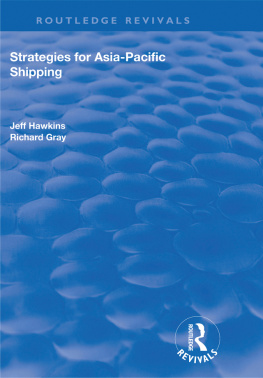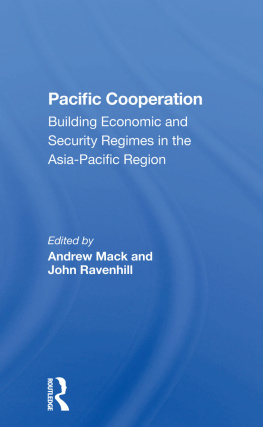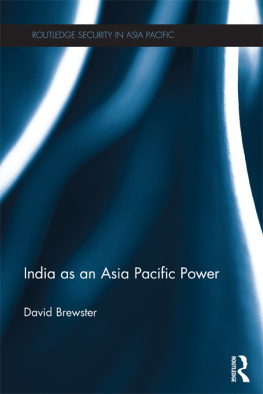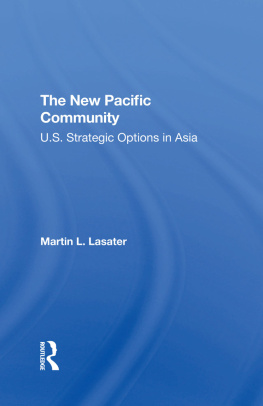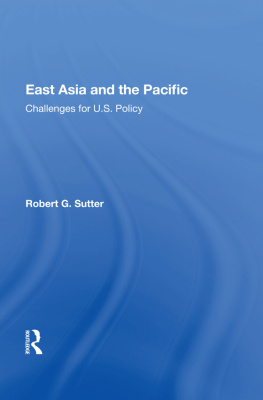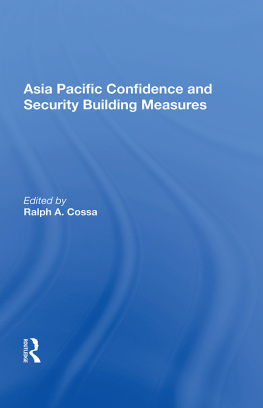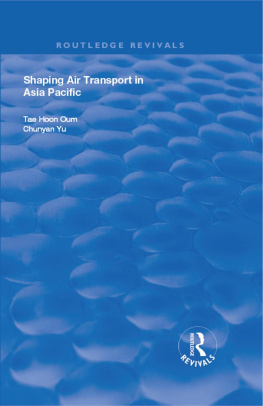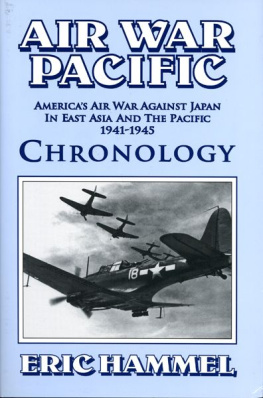Strategies for Asia-Pacific Shipping
Strategies for Asia-Pacific Shipping
Jeff Hawkins
Asia Pacific Maritime Institute, Launceston, Australia
Richard Gray
Institute of Marine Studies, University of Plymouth
First published 2000 by Ashgate Publishing
Reissued 2019 by Routledge
2 Park Square, Milton Park, Abingdon, Oxon, OX14 4RN
52 Vanderbilt Avenue, New York, NY 10017
Routledge is an imprint of the Taylor & Francis Group, an informa business
Copyright Jeff Hawkins and Richard Gray 2000
All rights reserved. No part of this book may be reprinted or reproduced or utilised in any form or by any electronic, mechanical, or other means, now known or hereafter invented, including photocopying and recording, or in any information storage or retrieval system, without permission in writing from the publishers.
Notice:
Product or corporate names may be trademarks or registered trademarks, and are used only for identification and explanation without intent to infringe.
Publisher's Note
The publisher has gone to great lengths to ensure the quality of this reprint but points out that some imperfections in the original copies may be apparent.
Disclaimer
The publisher has made every effort to trace copyright holders and welcomes correspondence from those they have been unable to contact.
A Library of Congress record exists under LC control number:
ISBN 13: 978-1-138-73836-2 (hbk)
ISBN 13: 978-1-315-18483-8 (ebk)
Many people and organisations have provided help in producing this book. The authors would like to acknowledge the contribution of their respective organisations, the Asia Pacific Maritime Institute and the Institute of Marine Studies at the University of Plymouth, in the research and preparation of this book.
The Asia Pacific Maritime Institute funded this project as part of its ongoing efforts to produce quality research for the Asia Pacific maritime industry. Special thanks must also go to Luz Hawkins of the Asia Pacific Maritime Institute whose professional expertise and personal support has been highly pivotal to the success of this project.
At the University of Plymouth, special mention should be made of Harry Churchill, Kevin Cullinane, Michael Roe and Harry Heijveld for the expert advice and assistance they so willingly gave. Thanks also to Marie Bendell for secretarial support.
Finally, our deep gratitude to all the participants in the survey, interviews, and simulations without whom this work would not have been possible.
Jeff Hawkins, Launceston, Australia
Richard Gray, Plymouth, UK
Over the past several decades, the rapid globalisation of the market place has intensified competition within the already competitive shipping industry. This is particularly true in the Asia-Pacific region, which is predicted to dominate international trade in the twenty-first century. It is a certainty that with this dynamic growth in trade will come an increased demand for shipping services. Asia-Pacific shipowners intent on taking advantage of this growth and successfully competing in the market place will require a strategic approach to the way they manage their organisations. Research suggests that strategy is the single most important factor leading to a firm's success or failure. A shipowner's choice of strategies, therefore, will be critical to its long-term market success.
The strategic management literature offers a wide range of strategy selection models but serious doubts have been raised over the applicability of these models to shipowners in general and Asia-Pacific shipowners in particular. Much of what is known about strategy is drawn from manufacturing industries; very little comes from the service industries, and even less from the maritime industry. Shipping-based research on strategy selection is limited, and very little is known about shipowners' strategic decision making behaviour. Practical tools to guide and inform shipowners in their strategy selection are also seriously wanting.
Criticism of existing strategy selection models highlights the general lack of empirical support for such models. Most have not undergone any empirical testing to establish their utility and reliability in enhancing an organisation's strategic decision making. Furthermore, although most models assume a generic nature, claiming broad applicability across businesses and industries, there is very little empirical evidence to support this claim. Indeed, there is growing evidence to the contrary.
These limitations to our current knowledge of strategy selection require greater scrutiny and examination. If we are fully to understand the application and effectiveness of strategy in a service industry like shipping, particularly in the context of a rapidly growing economic region like the Asia-Pacific, then it is critical that we learn more about how shipowners in the region actually make strategic choices. What factors do they consider when making strategic choices? What process do they follow to select and evaluate strategies? How does this behaviour compare with current theory on strategy selection? These are questions that this book aims to answer. Based on the results, a strategy selection model applicable to Asia-Pacific shipping is developed.
The study of strategy lies within the domain of strategic management, which has emerged as an important new discipline within the general field of management. In the last two decades, there has been a steady build-up in our knowledge of the subject, both in terms of theory and empirical evidence. Literature reviews conducted during that period (Snow and Thomas, 1994; Lyles, 1990; Morris, 1986, 1987; Thomas, 1984) show a steadily maturing field where conceptual and methodological debates continue to enrich and advance current understanding of strategic management. After more than two decades of research, there is now a substantial body of evidence to show that organisations practising strategic management tend to outperform those that do not (Collis and Montgomery, 1997; David, 1997; Hussey, 1994; Miller and Cardinal, 1994). The groundwork was laid by a number of studies conducted in the 1960s and 1970s (e.g. Wood and La Forge, 1979; Karger and Malik, 1975; Herold, 1972; Schoeffler et al 1974; Ansoff et al 1971; Eastlack and McDonald, 1970; Thune and House, 1970).
Thune and House (1970) carried out a study in 1965 to examine the performance of a number of companies over a 7-15 year period (i.e. since the introduction of formal planning in each company). They found that those who planned outperformed those that did not on three counts: earnings per share, earnings on common equity, and earnings on total capital employed. They also found that planners outperformed themselves based on records prior to the introduction of planning. Herold (1972) extended the study and also found that companies that planned outperformed those that did not. Other studies have provided further supporting evidence. Eastlack and McDonald (1970) studied 211 companies, 105 of which were among the Fortune 500. They concluded that CEOs who used strategic management concepts headed companies with the fastest growth rates. The following year, Ansoff et al (1971) examined the strategic decisions made by 93 companies regarding acquisitions over a 19-year period (1946-65). They found that on many financial and sales measures, as well as ability to predict the outcomes of planning activities, companies that used a strategic management approach performed better than those that did not.


